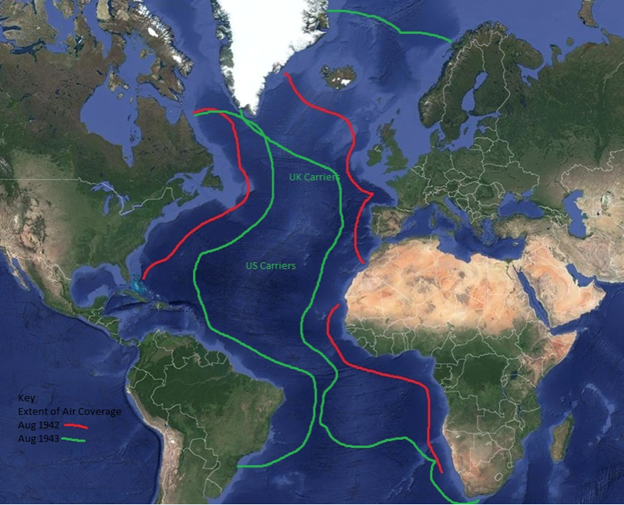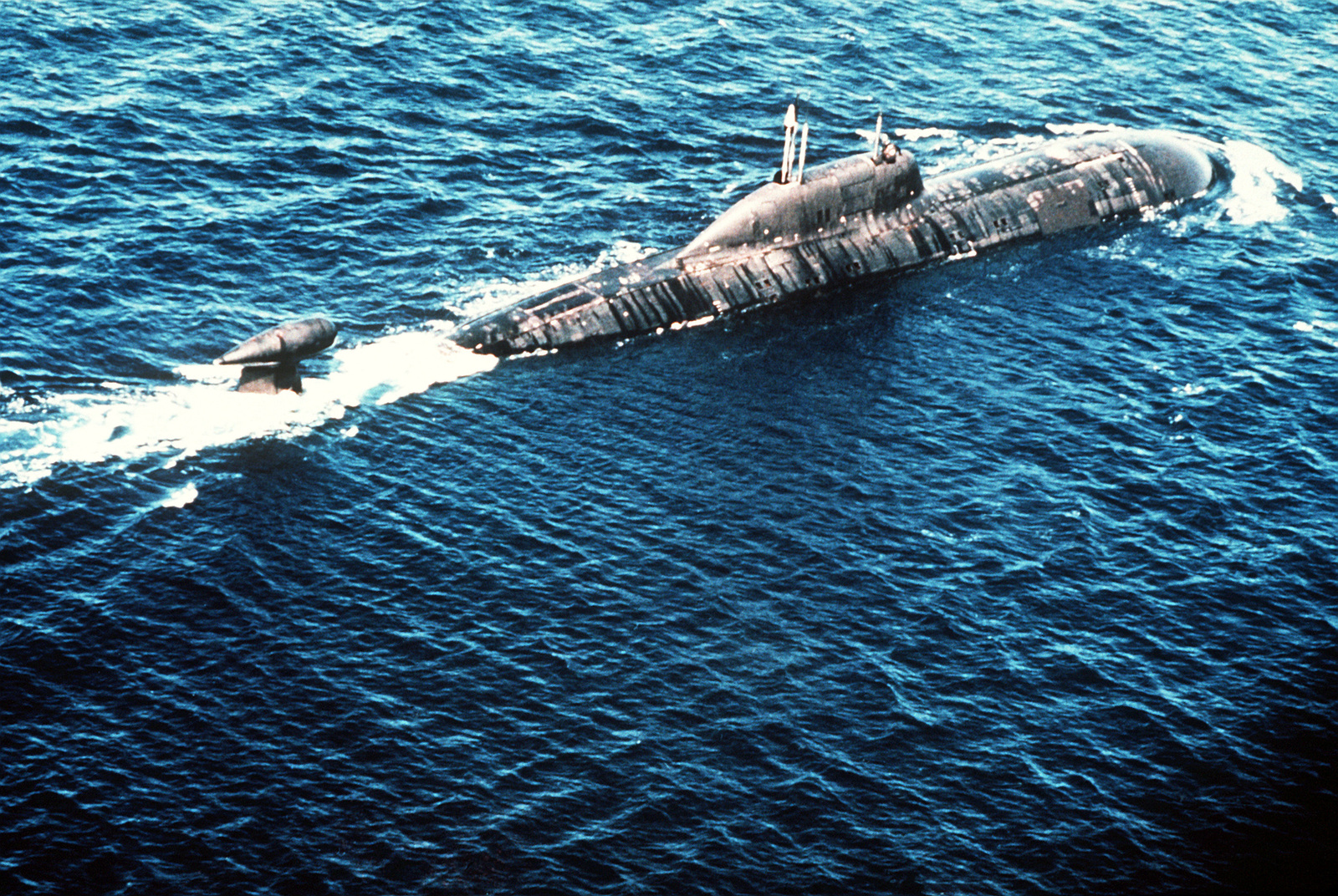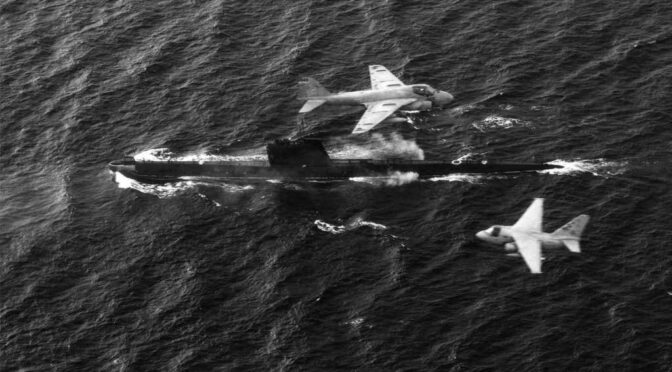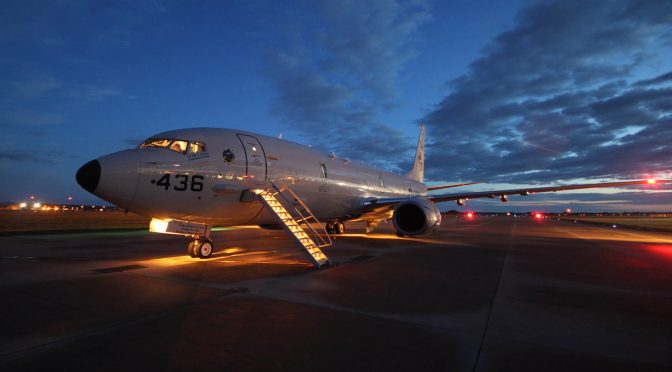By Jason Lancaster, LCDR, USN
Introduction
Anti-submarine warfare (ASW) is about putting sensors and weapons in place to detect and destroy submarines. The types of sensors have changed based on technological improvements and types of submarines, but the main principle is minimizing the sensor coverage gaps and engaging the submarine before it is within its weapons engagement zone (WEZ). Speed, endurance, and flexibility make aircraft excellent ASW platforms. It enables them to conduct wide-area searches and engage submarines before a submarine can attack.
Airpower is vital to protecting the center of gravity. In the Second World War, the European naval war’s center of gravity was the trans-Atlantic convoys that supplied the Allies’ war effort. The Allied struggle was to reduce air coverage gaps in the Atlantic to effectively protect convoys. In order to convoy ships across the Atlantic, the Allies had to close the gaps in air coverage. During the Cold War Era, the center of gravity was the power projection capability of the carrier. The challenge was to protect the carrier both for convoy protection and force projection. Today, the challenge to protect the carrier remains, and a dangerous new gap needs to be closed.
The Russian and Chinese navies have invested heavily in building quiet submarines capable of firing Anti-Ship Cruise Missiles (ASCMs) in excess of 200 nm. These missiles threaten our Carrier Strike Groups (CSGs) because the CSG lacks an organic capability to detect and engage these submarines outside of the submarines’ WEZ. This is not the first time that we have dealt with an increasingly dangerous submarine threat. Today, the U.S. center of gravity for naval combat remains the CVN. To defend the CVN or any high value vessels from submarines, we may find the answer to be similar to what it was in World War II and the Cold War. We can explore the U.S. Navy’s historical use of air power and technology to overcome submarine advantages and then explore future improvements to close the gaps using unmanned aircraft.
The Second World War
The Battle of the Atlantic tested the Allies’ ability to defend trans-Atlantic convoys at points throughout the European Theater of Operations, from Archangel to Cape Town and the Panama Canal to the Suez Canal; convoys had to be protected from submarines. Allied victory in the Battle of the Atlantic was the result of the Allies’ ability to eliminate gaps in air coverage with long range air and carrier-based convoy escorts. The challenge for the Allies was to extend air coverage to cover the entire convoy route. The Allies closed air coverage gaps in three ways: they expanded the number of air stations, developed longer-range aircraft, and integrated the escort carrier (CVE).
In August 1942, aircraft were limited to proximity from the U.S., Canada, Iceland, Northern Ireland, Gibraltar, and the African coast. Air coverage decreased the number of attacks in the western approaches to the English Channel. However, the German U-boats continued their depredations farther to sea into an area where aircraft could not reach. The Navy had to continue to close coverage gaps.
In order to close gaps, the Navy went to work opening air bases around the Atlantic rim to expand air coverage. From Greenland to Brazil, the U.S. worked with host nations to build and develop airfields. Unfortunately, gaining permission to operate an airfield did not mean planes could start flying right away. For example, the Danish government in exile gave the United States permission to operate aircraft out of Narsarsuaq, Greenland in April 1941; VP-6 aircraft did not operate from there until October 1943. In Natal, Brazil, the Navy took over facilities that Pan Am had been developing in 1940, but the facilities did not officially become active until 1943. In the Caribbean, planes flew convoy routes from Coco Solo, Panama to Trinidad and on to San Juan, Puerto Rico.

The Navy acquired the bases to operate from, but to close the gaps, aircraft were required to patrol from those bases. The Navy began the war with long-range aircraft, but not the vast numbers required for the massive amount of ocean requiring protection. Thousands of hours of patrol time were required to detect a submarine, creating a massive demand for aircraft. Congress passed the Two Ocean Navy Act in 1940, but aircraft production and aviation training had to catch up to wartime demand. 49 fixed-wing patrol (VP) squadrons were formed in 1943 alone. The influx of new planes and aircrews allowed the Allies to swarm the Atlantic.
This influx of planes enabled the Navy to cover the Atlantic in aircraft and force the U-boats to change tactics. In 1940, U-boats had submerged at the first sight of an aircraft. Many of those aircraft lacked effective weapons to sink a U-boat. Improvements to depth charges, radar, and searchlights increased the kill count. By 1943, U-boats had been re-armed with quadruple 20 mm anti-aircraft guns and traveled the Bay of Biscay surfaced in packs for mutual defense against aircraft. Submarines shooting it out with aircraft resulted in the sinking of 34 submarines in the Atlantic in July 1943. Between August and December of 1943, the Allies flew 7,000 hours of patrols in the Bay of Biscay alone. 7,000 hours translated to 36 sightings, 18 attacks, and 3 kills. Although the number of sightings was low, the U-boats had implemented a policy of maximum submergence, reducing their ability to travel rapidly on the surface during daylight.
Despite increased bases and more aircraft, the center of the Atlantic remained out of reach to land-based aircraft. This gap was closed by escort carriers (CVEs). These aircraft carriers were converted from merchant ships and equipped with a flight deck and a composite squadron of approximately 20 carrier aircraft; typically F4F Wildcats and TBF Avengers. Escort carriers operated in two main modes; direct support to convoys flying patrols around the convoy searching for U-boats, or as the flagship of a hunter-killer squadron. Initially, the aircraft only flew daytime missions, but submarines would surface to recharge their batteries at night. The aircraft flying off escort carriers became the first to regularly fly night missions. Escort carrier groups sank 53 U-boats during the war, including 60 percent of all U-boats sank between April and September of 1944.

By June 1944, U-boats operated primarily submerged utilizing snorkels. The Allies’ ability to build airbases, manufacture planes, and convert aircraft carriers from merchant ships had enabled them to patrol the entirety of the Atlantic, giving the U-boats nowhere to escape. Staying submerged dramatically reduced submarine range and speed, and there were more U-boat losses than merchant ship losses by the end of 1944. Closing the air coverage gaps in the Atlantic enabled the United States to transport armies across the ocean, maintain the supply lines to the Soviet Union and Great Britain, and win victory in Europe.
The Cold War
During the Cold War, the Navy focused resources into the ability to project power ashore by building carrier battle groups and operating them in the eastern Mediterranean and the high north. The Cold War carrier battle group had to contend with Soviet long-range naval aviation, as well as nuclear and diesel submarines. Protecting the carrier against nuclear and diesel-electric submarines required defense-in-depth to prevent coverage gaps where submarines could freely target the carrier.
In the early years of the Cold War, World War II-era aircraft carriers were converted to ASW carriers (CVS) and operated 20 S-2 Trackers and 16-18 ASW helicopters and their escorts. During the 1950s, the U.S. maintained 20 ASW battle groups composed of a CVS and escorts. Budget constraints, a focus on the Vietnam War, and the increasing maintenance costs of aging ships resulted in the decommissioning of CVSs through the late 1960s. To maintain carrier-based airborne ASW, the CV replaced an attack squadron (VA) with an air ASW squadron (VS).
Exercises such as Ocean Venture ’81 had demonstrated the Navy’s global reach and ability to place strike aircraft on the Soviet border undetected. The Soviets wanted to deny the eastern Mediterranean and the high north to carrier battle groups to protect the Soviet Union from these attacks. The Soviets’ primary means of denial were their massive submarine fleet and long-range aviation assets. The U.S. expected the Soviets to attack the convoy routes that would bring additional U.S. troops, equipment, and stores to Europe, as well as target the carrier battle groups.
The U.S. developed an ASW system to protect both convoys and battle groups. Submarines and maritime patrol reconnaissance aircraft (MPRA) could patrol independently, but also received cueing from the Sound Surveillance System (SOSUS). SOSUS arrays stretched across the gaps that Soviet submarines would travel to reach the north Atlantic Ocean; from Bear Island to the Norwegian coast, and across the Greenland-Iceland-UK gaps (GIUK). These arrays were monitored by acoustic technicians and able to vector submarines and MPRA to pounce on Soviet submarines as they transited into the north Atlantic. These barriers formed the outer submarine defensive zones that would enable the U.S. to kill Soviet submarines in chokepoints. The role of these submarines and MPRA was sea denial.

Convoys would be supported by helicopter-equipped ASW frigates and destroyers and MPRA operating from bases in Canada, Iceland, the Azores, and the United Kingdom. The mission of these escorts was not to create permanent sea control, but to create a bubble of temporary local sea control that would enable the convoyed merchant ships to reach Europe without losses. Carrier battle groups would support these convoys, as required, to protect against air attacks, or would head to the Norwegian coast to conduct offensive operations against the Soviet Union.
The purpose of the carrier battle group was sea control. The typical carrier battle group was composed of an aircraft carrier, 8-10 escorting cruisers, destroyers, and frigates, and the air wing. The carrier battle group utilized defense-in-depth to defend the carrier. The most distant ring was the inorganic theater ASW (TASW) fight utilizing the SOSUS network, MPRA, and submarines. The battle group did not lead this fight, but paid attention to it.
Submarines that transited past the MPRA, submarine, and SOSUS barriers required the battle group’s anti-submarine warfare commander (ASWC) to defend the carrier. The 1980s battle group’s ASW plan was composed of three zones: the outer zone (100-300NM), the middle zone (30-70NM), and the inner zone (0-30NM). The battle group’s organic outer defense was composed of ASW helicopter-equipped frigates or destroyers with towed acoustic arrays. The VS squadron and helicopter anti-submarine squadron (HS) were to patrol the inner and middle zones, but maintained the ability to pounce in the outer zone, as required. The inner screen was composed of 3-4 destroyers or frigates utilizing active sonar. Active sonar was required because the carrier and its inner screen utilized speed and maneuver to minimize the ability of a submarine to target the carrier. The noise of speed negated passive tracking.

Victory for the TASW MPRA, submarine, and SOSUS team was the number of submarines destroyed. The battle group’s victory was defined avoiding an attack, whether that was from killing submarines, utilizing limiting lines of approach and maneuver, or defense-in-depth deterrence to prevent submarines from closing on the carrier. The Navy utilized multiple assets with different capabilities and limitations to prevent gaps in the carrier’s screen. TASW, multiple surface ships, CV, DD, and FF-based helicopters and ASW aircraft all contributed to the successful defense of the carrier. The skilled ASWC was able to balance the strengths and weaknesses of each part of the screen and keep the Soviet submarine away from the carrier.
ASW Today and Tomorrow
The threat of Soviet submarines seemingly disappeared with the collapse of the Soviet Union. Without the threat of Soviet submarines, U.S. interest in ASW withered. The nation’s peace dividend included the cancellation of the P-3 replacement aircraft, and the reduction of MPRA squadrons from 24 to 12 between 1989 and 1996. The remaining P-3s found their sensors optimized for detecting surfaced submarines and were useful to the Joint Force flying ISR missions over the Balkans and the Middle East. These missions sustained the reduced MPRA force through the budget cuts of the 1990s and the land combat-centric days of the War on Terror. The S-3B Vikings left their ASW role behind and performed mission tanking duties for F/A-18s before being prematurely retired, many with almost 10,000 flying hours left in them.
In the 2010s, a new generation of ASW aircraft was flying. The P-8A Poseidon replaced the P-3C Orion and the MH-60R replaced the SH-60B and SH-60F. As witnessed during multiple ASW exercises, the combination of P-8As and MH-60Rs is nearly unstoppable. However, there is a clear capability gap at the strike group level. As a theater asset, the P-8s are limited in number, and fly missions across the fleet. The MH-60R has tremendous capability, but a limited range. It is not designed for area searching, but localizing a contact or conducting datum searches.
Full Spectrum ASW’s 9th thread is, “defeat the submarine in close battle.” With modern ASCMs and over-the-horizon targeting, the close battle is at least 200 nm from the strike group. The strike group must rely on the theater ASW commander to prosecute any modern submarines. While the strike group is important for the TASW commander to protect, TASW has a limited number of available submarines and P-8s and a multitude of submarines to prosecute. An organic aircraft capable of long-range ASW would enable the strike group commander to defend a larger strike group operating area, freeing TASW assets for threads 5 (Defeat submarines in choke points), 6 (Defeat submarines in open ocean), and 7 (Draw the enemy into ASW “kill boxes”).
Today, the CSG is composed of an aircraft carrier and three to five escorting cruisers or destroyers, which is half the ships of a Cold War-era Carrier Battle Group, and an air wing. The main organic ASW aircraft are MH-60Rs, helicopters with outstanding capabilities, but limited range. There are no organic ASW aircraft in the carrier air wing capable of searching, localizing, tracking, and engaging submarines beyond the submarine’s WEZ.
MH-60Rs were not designed for area ASW searches and lack the endurance to search 200 nm from their ship. E-2 and EA-18G aircraft support the ASW fight with their capable radar and electronic warfare suites when the submarine is surfaced, or utilizing a periscope or radar. F-18s, C-2s, and MH-60Ss support primarily through visual search for submarines as they fly around the carrier. But searching for submarines visually or when surfaced are hardly ideal tactics.
Reducing the inner screen in order to get a ship out far enough to conduct a search in the outer zone is incredibly risky. A compelling solution is to establish an unmanned sea control squadron (VUS) squadron. These squadrons would provide Sea Combat Commanders with a dedicated medium-range ASW aircraft that would allow commanders to detect, classify, track, target, and engage submarines outside their WEZ. Everything the aircraft needs already exists. Equip a carrier-capable UAV with Forward Looking Infrared cameras (FLIR), AN/APS 153 radar, and ALQ-210 Electronic Support Measures systems from the MH-60R, LINK-16, active, passive, and Multi-Static Active Coherent (MAC) sonar buoys, and arm it with Mk 54 torpedoes and air-launched ASCMs.
This capable aircraft would directly support the Carrier Strike Group and enable it to engage submarines outside their WEZ. The technology exists. In order to protect the carrier today, the Navy needs to continue to close the gaps.
LCDR Jason Lancaster is a U.S. Navy Surface Warfare Officer. He has served aboard amphibious ships, destroyers, and as operations officer of a destroyer squadron. He is an alumnus of Mary Washington College and holds a Master’s Degree in History from the University of Tulsa. His views are his alone and do not represent the stance of any U.S. government department or agency.
Bibliography
Atkins, R.W. “ASW: Where is the Inner Screen?” Naval War College Review, January-February 1982: 48-49.
Barlow, Jeffrey. “The Navy’s Escort Carrier Offensive.” Naval History Magazine, November 2013.
Bernard, Colin. “Nobody Asked Me… But Bring Back the S-3 Viking.” Proceedings, January 2018.
Byron, John. “The Victim’s View of ASW.” Proceedings, April 1982.
Cote, Owen. The Third Battle of the Atlantic: Innovation in the U.S. Navy’s Silent Cold War Struggle with Soviet Submarines. Newport, Rhode Island: Naval War College Press, 2012.
Foggo, James, and Alarik Fritz. “The Fourth Battle of the Atlantic.” Proceedings, June 2016.
Friedman, Norman. “World Naval Developments: More Than a Tanker?” Proceedings, October 2018.
Frigge, William. “Winning Battle Group ASW.” Proceedings, October 1987.
Metrick, Andrew. “(Un)Mind the Gap.” Proceedings, October 2019.
Middleton, Drew. “U.S. AND ALLIED NAVIES STARTING MAJOR TEST TODAY.” New York Times, August 1, 1981: 1.
Naval History and Heritage Command. “Dictionary of American Naval Aviation Squadrons Volume 2.” The History of VP, VPB, VP(H) and VP(AM) Squadrons. Edited by Naval History and Heritage Command. Naval History and Heritage Command. n.d. https://www.history.navy.mil/research/histories/naval-aviation-history/dictionary-of-american-naval-aviation-squadrons-volume-2.html (accessed May 28, 2020).
Shugart, Thomas. “Build All-UAV Carriers.” Proceedings, September 207.
Stavridis, James. “Creating ASW Killing Zones.” Proceedings, October 1987.
Sternhell, Charles, and Alan Thorndike. OEG Report No 51: Anti-Submarine Warfare in World War II. Washington DC: Navy Department, 1946.
Toti, William J. “The Hunt for Full Spectrum ASW.” Proceedings, June 2014.
Voss, Philip. “Battle Force ASW: M3.” Proceedings, January 1989.
Wedewer, Harry. “Scout from the Sea.” Proceedings, September 1999.
Featured Image: An S-3 Viking and A-6 Intruder from the USS John F. Kennedy (CV-67) fly over a Soviet Foxtrot class diesel submarine. (U.S. Navy photo)




